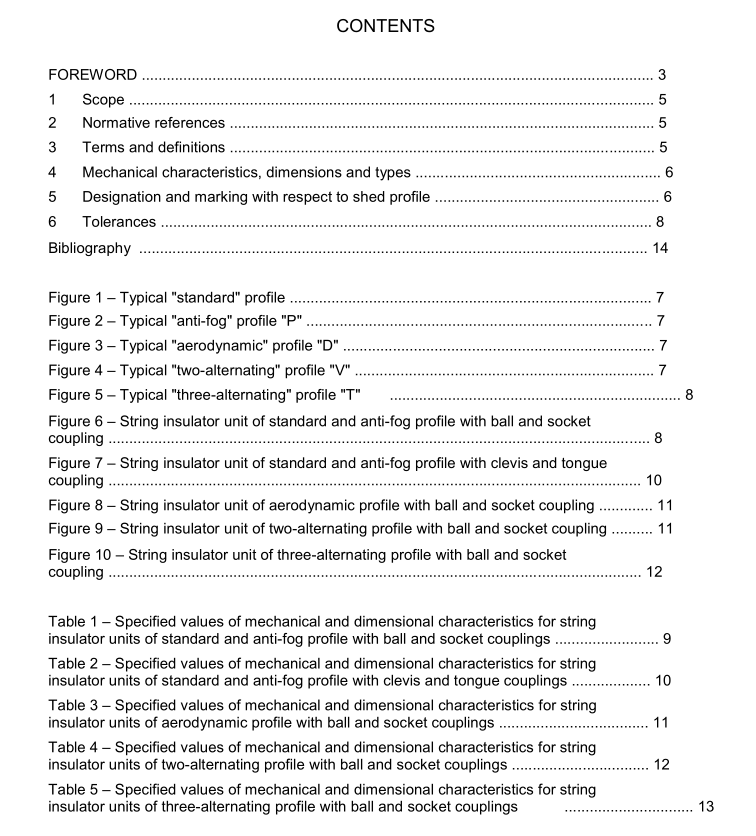IEC 60305 pdf – Insulators for overhead lines with a nominal voltage above 1 000 V – Ceramic or glass insulator units for AC systems – Characteristics of insulator units of the cap and pin type

IEC 60305 pdf – Insulators for overhead lines with a nominal voltage above 1 000 V – Ceramic or glass insulator units for AC systems – Characteristics of insulator units of the cap and pin type
1 Scope
This International Standard applies to string insulator units of the cap and pin type withinsulating parts of ceramic material or glass,intended for AC overhead lines with a nominalvoltage greater than 1 000 v and a frequency not greater than 100 Hz. lt also applies toinsulators of similar design used in substations.
This document applies to string insulator units of the cap and pin type either with ball andsocket couplings or with clevis and tongue couplings.
This document applies to string insulator units for use on overhead lines in clean areas andpolluted areas. For use in areas characterized by very heavy pollution levels and for otherparticular or extreme environmental conditions, it may be necessary for certain dimensions to
be changed and insulator units having different creepage distances,spacing and forms maybe preferred (for example,flat profile,hemisphericaletc.). Insulators for use on DC systemsmay also need different dimensions. In any case,it is applicable that the standardizedmechanical characteristics of this document and coupling sizes are retained.
The object of this document is to prescribe specified values for the mechanical characteristicsand for the main dimensions of string insulator units of the cap and pin type.
The power frequency,lightning impulse and puncture withstand voltages of string insulatorunits are not specified in this document. IEC 60383-1 gives the electrical characteristics which
define string insulator units; their values are agreed between purchaser and manufacturer.
Ball and socket couplings are covered by IEC 60120, clevis and tongue couplings byIEC 60471.
NOTE For the definition of site pollution severity see IEC TS 60815-1.Normative references
The following documents are referred to in the text in such a way that some or all of theircontent constitutes requirements of this document. For dated references,only the editioncited applies.For undated references, the latest edition of the referenced document (including
any amendments) applies.
IEC 60383-1,Insulators for overhead lines with a nominal voltage above 1000 v – Part 1:Ceramic or glass insulator units for AC systems – Definitions,test methods and acceptancecriteria
3Terms and definitions
No terms and definitions are listed in this document.
lSO and IEC maintain terminological databases for use in standardization at the followingaddresses:
.IEC Electropedia: available at http://www.electropedia.orgl
.Iso Online browsing platform: available at http:/ /www.iso.orglobp
4Mechanical characteristics,dimensions and types
String insulator units of the cap and pin type are standardized by the following specifiedcharacteristics:
– Specified electromechanical or mechanical failing load (SFL) according to IEC 60383-1;- maximum nominal diameter of the insulating part;
-nominal spacing;
– minimum nominal creepage distance;-standard coupling.
The corresponding values are indicated in Table 1,Table 2,Table 3, Table 4 and Table 5.
NOTE 1 The following points merit attention for insulators for use in polluted areas:
a) even if the creepage distance is the same, the withstand voltage characteristics may change with shed shape ofthe insulators;
b) even if the string length is the same,the withstand voltage characteristics may decrease with increasinginsulator strength due to the lower efficiency of creepage distance for a larger average diameter,
NOTE 2 IEc 60815 gives detaiis on the important parameters of shed profiles for antipollution insulators.
5 Designation and marking with respect to shed profile
Insulators are designated in Table 1,Table 2,Table 3,Table 4 and Table 5 by the letter ufollowed by a number indicating the specifiedelectromechanicalor mechanical failing load inkilonewtons.
The letter B or C which follows specifies a ball and socket or clevis and tongue, respectively.The following letter S or L, if present, specifies a short or long spacing.
The letter P,D,V, or T present for “anti-fog” profile,”aerodynamic” profile,”two-alternating”profile,or “three-alternating” profile,as shown in Figure 1,Figure 2,Figure 3,Figure 4 andFigure 5, respectively.
IEC 60383-1 specifies that insulators shall be marked with the specified electromechanical or
mechanical failing load. This load may be indicated by using the first part of the designationgiven in the first column of Table 1, Table 2, Table 3,Table 4 and Tabie 5: For instance,theinsulator may be marked U 160 for the units U 160 BS,U 160 BL and U 160 BLP.









